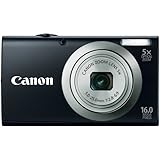Design and Features
One of the nicer things about the A2300 is its build quality. The compact camera features a metal body that feels much more solid than the plastic enclosures found on other budget cameras. It is only 2.1 by 3.7 by 0.8 inches (HWD) in size and weighs 4.4 ounces. Our review unit was what Canon calls red—but is in reality more on the magenta side of things—and the camera is also available in blue, black, or silver versions.
The 5x zoom lens covers a 28-140mm (35mm equivalent) focal range, which is pretty nice for a cheap camera. Nicer still is the fact that it has an f/2.8 aperture at the wide end, which should help to make up for some of its high ISO shortcomings. Do not expect to zoom all the way in and capture a lot of light though—at its telephoto extreme the lens closes down to f/6.9, which will require you to be working in good light to get a shutter speed fast enough to get sharp telephoto images. This is one area where the lack of image stabilization really comes into play.
The physical control layout is identical to that of the A2400 IS . The Zoom Rocker, Power switch, and Shutter release are located on the top of the camera with the rest of the controls on the rear to the right of the LCD. There are buttons to activate Macro mode, toggle between Auto and other shooting modes, and control the Flash. A Record button activates HD video capture, and there is a Help button that brings up an on-screen manual.
The rear LCD is 2.7 inches in size and has a 230k-dot resolution. It isn't as sharp as the ones you'll find on more expensive cameras, but it's noticeably nicer than 3-inch screens of identical resolution. If you opt to shoot in a mode other than Auto, an overlay menu is activated by hitting the center Function button on the rear of the camera. It's quite responsive, and makes it possible to adjust Exposure Compensation, ISO, White Balance, the Drive Mode, and other common shooting settings.
 |
| BUY CANON A2300 BLACK At AMAZON CLICK HERE |
Performance and Conclusions
When you consider its price, the speed that the Canon A2300 delivers is really quite impressive. It can start up and grab a shot in 2.1 seconds, rattles off a photo every 1.4 seconds in continuous drive mode, and has a short 0.2 second shutter lag.
When you consider its price, the speed that the Canon A2300 delivers is really quite impressive. It can start up and grab a shot in 2.1 seconds, rattles off a photo every 1.4 seconds in continuous drive mode, and has a short 0.2 second shutter lag.
The sharpness of the camera's lens is pretty impressive. According to Imatest the A2300 records 1,939 lines per picture height at its widest angle setting. This exceeds the 1,800 lines that denote a sharp image.




PHOTO SHOOT WITH CANON A2300
PHOTO SHOOT WITH CANON A2300
The camera doesn't fare as well in terms of noise control. Its small sensor is packed with 16-megapixels of resolution, and is a CCD—a technology that doesn't do as well at higher ISO settings as CMOS does. Images from the camera are below the 1.5 percent noise threshold at its base ISO setting of 100, increasing slightly to 1.8 percent at ISO 200 and 400, and topping out at 2.8 percent at ISO 1600. The camera also performs some pretty aggressive noise reduction at ISO 800 and 1600—fine detail is almost completely erased from photos at those settings. You should be able to get acceptable, albeit slightly grainy, results by keeping the camera's ISO set to 400 or below and using the flash as necessary.
The A2300 can record QuickTime video in 720p25 format, which isn't great for fast motion, but does give a rather cinematic feel to the footage as it is close to the frame rate used by most movie cameras. The footage looks ok, but there is evidence of some compression and video compression, even under studio lighting. The camera's lens isn't able to zoom in or out when you're recording video, nor can it refocus once recording is started. Digital zoom is supported, but the quality of the video starts to degrade dramatically the moment that you activate it. The A2300 has a standard mini USB port to connect to a computer and supports SD, SDHC, and SDXC memory cards.
If you're looking for a good camera on a budget, the A2300 would be a good way to go—if it weren't for the A2400 IS. The extra ten dollars you spend on that camera brings image stabilization to the table, which should help you keep the ISO setting a bit lower. If you're on a very strict budget, you can save a little money and opt for Panasonic Lumix DMC-S3 and features an optically stabilized 4x zoom lens.
RELATED TOPIC:
NIKON D800 Samsung WB150F Samsung MV800 Canon EOS REBEL T3






